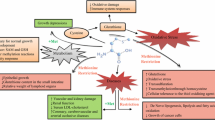Abstract
This review summarizes the literature regarding nutritional regulation of the pathways of glutathione synthesis and subsequent conjugation of xenobiotic compounds. The glutathione detoxification pathway includes the enoymes of the gamma-glutamyl cycle as well as sulfur conjugation reactions. This promotes bodily excretion of xenobiotics as well as normal metabolites. Regulation of intracellular glutathione concentrations is maintained largely through changes in the activity of gamma-glutamylcysteine synthetase. Availability of glutathione for detoxification purposes can be limited by the supply of intracellular cysteine to serve as a precursor for glutathione synthesis through the gamma-glutamyl cycle. Dietary methionine, cysteine and cysteine prodrugs have been examined for their potential to maximize glutathione availability for detoxification purposes. Some xenobiotic challenges have been reported to deplete hepatic glutathione reserves and toxicity correlates with the degree of depletion. Other foreign compounds, however, have been observed to increase cellular glutathione concentrations beyond normal levels despite regulation of the synthetic pathway. Such effects will be reviewed.
Access this chapter
Tax calculation will be finalised at checkout
Purchases are for personal use only
Preview
Unable to display preview. Download preview PDF.
Similar content being viewed by others
References
Ansher, S.S., Dolan, P., and Bueding, E. (1986). Biochemical effects of dithiolthiones. Fd. Chem. Toxic, 25, 581–587.
Batiman, P.F., Smith, T.K., and Bray, T.M. (1988a). The effect of dietary protein and sulfur amino acids on hepatic glutathione concentration and glutathione-dependent enoyme activities in the rat. Can. J. Physiol. Pharmacol., 66, 1048–1052.
Bauman, P.F., Smith, T.K., and Bray, T.M. (1988b). Effect of dietary protein deficiency and L-2-oxothiazolidine-4-carboxylate on the diurnal rhythm of hepatic glutathione in the rat. J. Nutr., 118: 1048–1054.
Boebel, K.P. and Baker, D.H. (1983). Blood and liver concentrations of glutathione, and plasma concentrations of sulfur-containing amino acids in chicks fed deficient, adequate, or excess levels of dietary cysteine. Proc. Soc. Exper. Biol. Med., 172, 498–501.
Bogaards, J.J. P., van Ommen, B., Falke, H.E., Willems, M.I., and van Bladeren, P.J. (1990). Glutathione S-transferase subunit induction patterns of brussels sprouts, allyl isothiocyanate and goitrin in rat liver and small intestinal mucosa: a new approach for the identification of inducing xenobiotics. Fd. Chem. Toxic, 28, 81–88.
Cho, E.S., Johnson, N., and Snider, B.C.F. (1984). Tissue glutathione as a cyst(e)ine reservoir during cystine depletion in growing rats. J. Nutr., 114, 1853–1862.
Chung, T.K., Funk, M.A., and Baker, D.H. (1990). L-2-oxothiazolidine-4-carboxylate as a cysteine precursor: Efficacy for growth and hepatic glutathione synthesis in chicks and rats. J. Nutr., 120, 158–165.
Goyal, R. and Brodeur, J. (1987). Effect of a cysteine prodrug (L-2-oxothiazolidine-4-carboxylic acid) on the metabolism and toxicity of bromobenzene: a repeated exposure study. J. Toxlcol. Environ. Health. 21, 325–340.
Jaeschke, H. and Vendei, A. (1986). Manipulation of mouse organ glutathione contents II: Time and dose-dependent induction of the glutathione conjugation system by phenolic antioxidants. Toxicology, 39, 59–70.
Kawakishi, S. and Kaneko, T. (1985). Interaction of oxidized glutathione with allyl isothiocyanate. Phytochemlstry, 24, 715–718.
Meister, A. (1984). New aspects of glutathione biochemistry and transport-selective alteration of glutathione metabolism. Nutr. Rev., 42, 397–410.
Meister, A. (1988). Glutathione metabolism and its selective modification. J. Biol. Chem., 263, 17205–17208.
Stoewsand, G.S., Anderson, J.L., and Lisk, D. (1986). Changes in liver glutathione S-transferase activities in cotumix quail fed municipal sludge-grown cabbage with reduced levels of glucosinolates. Proc. Soc. Exper. Biol. Med., 182, 95–99.
Stohs, S.J., Lawson, T.A., Anderson, L., and Bueding, E. (1986). Effects of oltipraz, BHA, ADT and cabbage on glutathione metabolism, DNA damage and lipid peroxidation in old mice. Mech. Ageing. Dev., 37, 137–145.
Uda, Y., Kurata, T., and Arakawa, N. (1986). Effects of thiol compounds on the formation of nitriles from glucosinolates. Agric.Biol. Chem., 50, 2741–2746.
Wallig, M.A. and Jeffrey, E.H. (1990). Enhancement of pancreatic and hepatic glutathione levels in rats during cyanohydroxybutene intoxication. Fundam. Appl. Toxicol., 14, 144–159.
Whitty, J.P. and Bjeldanes, L.F. (1987). The effects of dietary cabbage on xenobiotic metabolzing enoymes and the binding of aflatoxin B1 to hepatic DNA in rats. Fd. Chem. Toxic. 25, 581–587.
Williamson, J.M., Boettcher, B., and Meister, A. (1982). Intracellular cysteine delivery system that protects against toxicity by promoting glutathione synthesis. Proc. Natl. Acad. Sci. U.S.A., 79, 6246–6249.
Wong, B.K., Chan, H.C., and Corcoran, G.B. (1986). Selective effects of N-acetylcysteine stereoisomers on hepatic glutathione and plasma sulfate in mice. Toxicol. Appl. Pharmacol., 86, 421–429.
Author information
Authors and Affiliations
Editor information
Editors and Affiliations
Rights and permissions
Copyright information
© 1991 Springer Science+Business Media New York
About this chapter
Cite this chapter
Smith, T.K. (1991). Dietary Modulation of the Glutathione Detoxification Pathway and the Potential for Altered Xenobiotic Metabolism. In: Friedman, M. (eds) Nutritional and Toxicological Consequences of Food Processing. Advances in Experimental Medicine and Biology, vol 289. Springer, Boston, MA. https://doi.org/10.1007/978-1-4899-2626-5_14
Download citation
DOI: https://doi.org/10.1007/978-1-4899-2626-5_14
Publisher Name: Springer, Boston, MA
Print ISBN: 978-1-4899-2628-9
Online ISBN: 978-1-4899-2626-5
eBook Packages: Springer Book Archive



